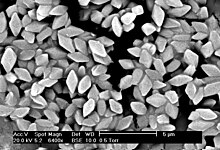Bacillus thuringiensis
| Bacillus thuringiensis | |
|---|---|
 |
|
| Spores and bipyramidal crystals of Bacillus thuringiensis morrisoni strain T08025 | |
| Scientific classification | |
| Domain: | Bacteria |
| Phylum: | Firmicutes |
| Class: | Bacilli |
| Order: | Bacillales |
| Family: | Bacillaceae |
| Genus: | Bacillus |
| Species: | B. thuringiensis |
| Binomial name | |
|
Bacillus thuringiensis Berliner 1915 |
|
Bacillus thuringiensis (or Bt) is a Gram-positive, soil-dwelling bacterium, commonly used as a biological pesticide. B. thuringiensis also occurs naturally in the gut of caterpillars of various types of moths and butterflies, as well on leaf surfaces, aquatic environments, animal feces, insect-rich environments, and flour mills and grain-storage facilities.
During sporulation, many Bt strains produce crystal proteins (proteinaceous inclusions), called δ-endotoxins, that have insecticidal action. This has led to their use as insecticides, and more recently to genetically modified crops using Bt genes, such as Bt corn. Many crystal-producing Bt strains, though, do not have insecticidal properties.
B. thuringiensis was first discovered in 1901 by Japanese biologist Ishiwata Shigetane. In 1911, B. thuringiensis was rediscovered in Germany by Ernst Berliner, who isolated it as the cause of a disease called Schlaffsucht in flour moth caterpillars. In 1976, Robert A. Zakharyan reported the presence of a plasmid in a strain of B. thuringiensis and suggested the plasmid's involvement in endospore and crystal formation.B. thuringiensis is closely related to B.cereus, a soil bacterium, and B.anthracis, the cause of anthrax; the three organisms differ mainly in their plasmids. Like other members of the genus, all three are aerobes capable of producing endospores.
...
Wikipedia
